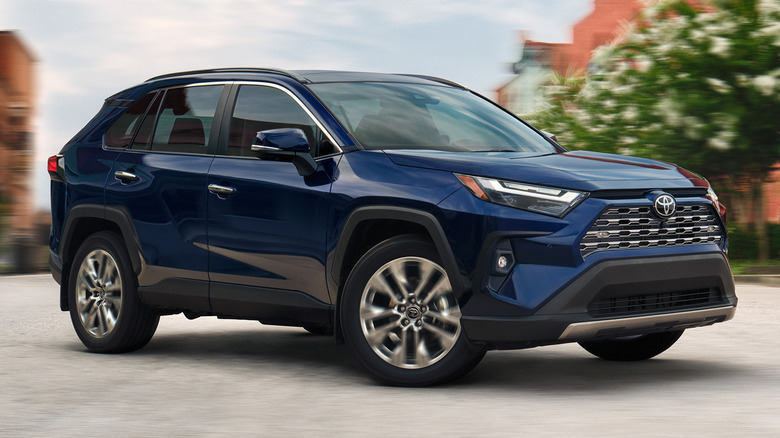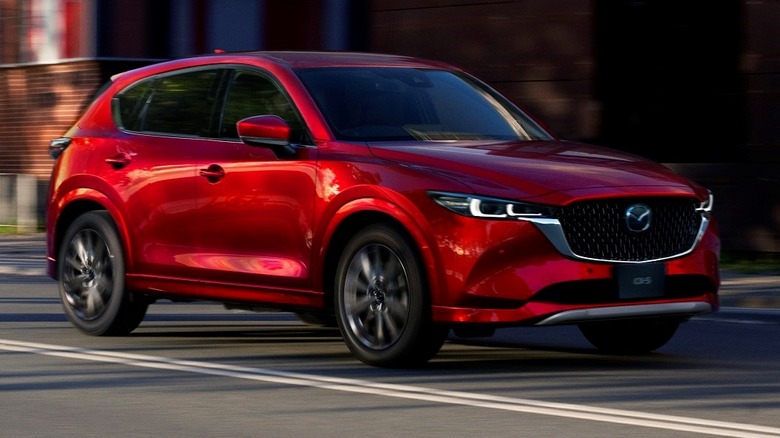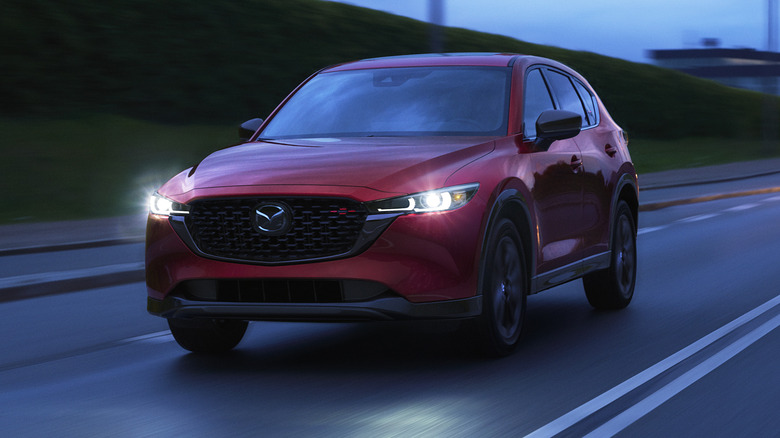Which Mazda SUV Model Is Comparable To Toyota's RAV4? (And How Much Does It Cost?)
As a compact SUV, the Toyota RAV4 is excellent at its job. It is spacious, practical, comfortable, reliable, fuel-efficient, and easy to drive in the city. Put simply, the RAV4 is everything most buyers love in a compact SUV, as reflected in its sales success. But there's also an ever-increasing number of great alternatives to consider if you're looking for something similar. Mazda's lineup, for example, consists of a couple of standout SUVs that are comparable to the Toyota RAV4, with the CX-5 being one of the more natural alternatives.
Like the RAV4, the Mazda CX-5 is safe, reliable, comfortable, and versatile. And, while it's slightly more affordable than the RAV4 in the base trim at a hair over $30,000, the CX-5 doesn't feel like a budget alternative. In fact, the CX-5 actually has more premium materials inside than the RAV4. It's also reputedly more fun to drive than its Toyota counterpart. However, the RAV4 offers more cargo space and better fuel efficiency than the Mazda CX-5.
The two SUVs trade blows overall, as each has the upper hand in different areas. Hence, we've compared the Mazda CX-5 vs. Toyota RAV4 side by side to help you find out how the two match up in terms of their fuel economy ratings, prices, cargo space, tech features, and more.
Mazda's CX-5 is more affordable than the Toyota RAV4
If you're in the market for a new compact SUV, you'll find the base-spec 2025 Mazda CX-5 is a little cheaper to buy brand new than the 2025 Toyota RAV4, with the base Mazda 2.5 S trim priced from $30,190 (including a $1,420 delivery charge). That amount nets you 17-inch alloy wheels, a 10.25-inch infotainment system, wired Apple CarPlay and Android Auto, a leather-wrapped steering wheel, manually adjustable front seats, and cloth upholstery. Higher trims offer amenities such as heated and ventilated front seats, heated rear seats, layered wood trim, Nappa leather upholstery, and wireless smartphone charging.
By comparison, the entry-level 2025 Toyota RAV4 LE starts at $30,700 (including a $1,450 destination fee). It comes standard with 17-inch steel wheels, cloth seats, a power-adjustable driver's seat, an 8.0-inch touchscreen display, a Wi-Fi hotspot, as well as wireless Apple CarPlay and Android Auto, which gives it a slight edge in the tech department. Expectedly, the amenities and material quality improve in higher RAV4 trims, with push-button start, heated and ventilated front seats, a leather steering wheel, and synthetic leather upholstery all available. However, the CX-5 still has nicer materials overall.
One area where the RAV4 really stands out, though, is in its exceptional practicality. Its cargo area is significantly larger than the CX's, with up to 37.5 cubic feet of space behind the second row. Fold that down, and you have a whopping 69.6 cubic feet of room to play with. The Mazda CX-5 has a still-useful 29.1 cubic feet of space with all seats in use and a maximum of 59.3 cubic feet with the rear seats down.
The RAV4 is more powerful than the CX-5
The Toyota RAV4 is the more powerful of the two compact SUVs overall. Its non-hybrid models feature a standard 2.5-liter four-cylinder engine producing 203 hp and 184 lb-ft of torque. If you're after something more potent, the RAV4 Hybrid model couples the 2.5-liter four-cylinder engine with three electric motors for 219 hp in total. If that's still not enough, there's the plug-in-hybrid RAV4, which combines a 2.5-liter four-cylinder engine, two electric motors, as well as an 18.1-kWh battery pack for a combined 302 hp.
The fuel economy winner here is the RAV4 Hybrid we tested recently, with a combined 39 mpg according to the EPA. The plug-in hybrid version returns a similar 38 mpg and can travel up to 42 miles on battery power alone. For gasoline RAV4 models, fuel economy is in the region of 28 to 30 mpg, depending on trim level.
The Mazda CX-5, meanwhile, offers two engine options: a standard 187-hp four-cylinder engine and a 256-hp turbocharged version. At its best, fuel economy in the naturally aspirated Mazda CX-5 is the same as the least-efficient Toyota RAV4 at 28 mpg, while the turbo-four averages a comparably lower 24 mpg. Still, the CX-5 has certain advantages over the RAV4, one of which is that it comes standard with all-wheel drive, whereas the base RAV4 has front-wheel drive. The CX-5 is also a better pick if you're after something more entertaining to drive. Before you go ahead and take the plunge, though, here are 10 things to know before buying the Mazda CX-5.


